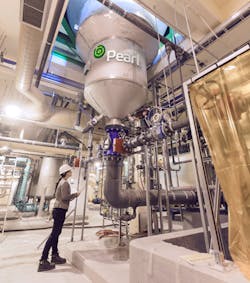The Big Question: What operational benefits and political motivation could help persuade utilities to install nutrient recovery systems?
WWi's technology comparison series continues with the topic of nutrient recovery solutions. With excess nutrients leading to Harmful algae blooms (HABs) and eutrophication, ultimately affecting utilities is now is the time for the adoption in modern technologies?
Closing the loop
Steve Wirtel, senior vice president, Ostara
Utilities are looking for sustainable wastewater treatment solutions. Increasingly, utilities are implementing nutrient recovery systems to address environmental concerns and economic challenges, both with political impact.
Nutrient pollution is a matter of a dislocated resource: we need nutrients to grow the food we eat, but nutrients in the water environment cause oxygen deficiency and hypoxia (dead zones). Nutrient recovery systems prevent nutrients from being discharged into the water environment by recovering and returning them to the agronomic cycle.
From an operational point of view, nutrient recovery is essential to help a utility meet its effluent phosphorus limits. When biological phosphorus removal is combined with anaerobic digestion, a natural phenomenon occurs.
This returns most of the phosphorus removed in the activated sludge process back to the treatment plant in the solids handling liquid side stream. A vicious cycle occurs where phosphorus is removed, released, and returned.
Nutrient recovery breaks this cycle, replacing it with a virtuous cycle where phosphorus is removed, released, and recovered.
In addition, nutrient recovery avoids the use of costly, unsustainable chemicals.
Without nutrient recovery, a utility must add metal salts to tie up the dissolved phosphorus in the solids handling liquid side stream when biological phosphorus removal is combined with anaerobic digestion.
Instead of adding chemicals, nutrient recovery captures phosphorus and nitrogen in the side stream, converting a problem into a solution by producing a high value, slow release fertilizer.
In fact, utilities across North America are seeing the benefits of nutrient recovery and bringing millions of revenue dollars into their facilities. But more than just seeing the monetary value, they are "closing the loop" on a non-renewable resource that is in limited supply and is essential to all forms of life, specifically farming and food production.
Without phosphorus, nothing grows, but too much negatively impacts water quality. Nutrient recovery allows utilities to address water quality challenges and "upcycle" an essential nutrient for the highest beneficial re-use.
As utilities move away from wastewater treatment and disposal towards the more sustainable approach - used water recycling - nutrient recovery is becoming a key component of resource recovery facilities.
UTILITY APPLICATION: CITY of SASKATOON
When Saskatoon's H.M. Weir Wastewater Treatment Plant upgraded to bio-phosphorus removal, the plant experienced two critical problems: excessive struvite scale in their lagoon supernatant return pipeline and struvite build up in their digesters as "grit", according to Ostara. Eventually, the supernatant return line became completely plugged with struvite, isolating the lagoons from the treatment plant. In August 2013, the City built an Ostara Pearl Nutrient Recovery facility with the waste activated sludge stripping process (WASSTRIP) to recover internal phosphorus , solve the struvite problem and restore plant reliability. The process has reduced struvite build-up and plant maintenance issues; resulted in lower operating and maintenance costs; and, improved efficiency and reliability. The facility features a Pearl 2000 reactor, which has the annual production capacity of 730 tonnes of fertilizer.
Reducing discharge fees
Dr Christian Kabbe, KompetenzZentrum Wassser Berlin
Focusing on phosphorus recovery from the wastewater stream, water utilities play a key role. Various technologies have been developed over recent years and a few of them have already made it to full-scale application, or are at least planned to start operation in the coming years.
Looking behind the scenes, these technologies not only provide recyclable phosphorus products like struvite, they also have some operational benefits, which are more or less the reason for installing such units.
We have heard all about the clogging of pipes and aggregates with unwanted struvite incrustation after the digestion of sewage sludge. This can cause serious trouble and additional maintenance cost for the operation of wastewater treatment plants.
Chemicals are available to avoid this trouble but are also quite expensive. So, why not opt for precipitating struvite after digestion on purpose? Different technology providers and plant operators already run such units.
There are two hot spots for struvite recovery at a wastewater treatment plant with biological phosphorus elimination and digestion of sludge: directly subsequent to the digester within the sludge matrix or after dewatering in the process water. In both cases, the dissolved ortho-phosphate will be recovered as struvite after pH adjustment and addition of magnesium salts.
In the first case - prior dewatering - additional benefits like improved sludge dewatering and reduced chemicals demand for dewatering can lead to reduction of sludge disposal costs in big wastewater treatment plants of several hundred thousand euros. So, the question arises, why haven't wastewater treatment plant operators of these bio-phosphorus plants installed recovery systems?
The very first point is the fact that phosphorus recovery is not essential for wastewater treatment (elimination of nutrients and pollutants). Finally, all the unwanted substances in the wastewater are either degraded or transferred into the sludge, which is only a by-product or waste of the treatment. It is not first intention of operators to produce another "product" besides effluent water meeting the legal requirements.
So, how to convince water utilities to install phosphorus recovery units, if they don't see benefits? Here, reasonable incentives and legal requirements come into place to generate motivation or even enforcement to do so.
Operators can be motivated by reduced discharge fees for a limited period when upgrading their plants or recovery quotes can be introduced. Of course, this should always be linked to practicability and not only scientific-political enacted. Also a market for recovered phosphorus will help. But this will only work, if there were a demand for recovered phosphorus.
This can also be triggered by legal requirements like strict limit values for Cadmium in fertilizers or a blending quota for recovered phosphorus in primary phosphorus products. A positive side effect will be that the existing distribution infrastructure can still be used and the quota can be increased according to growing quantities (availability) of recovered phosphorus.
It will also be a much cheaper solution to meet strict Cd limits by blending with pure recovery products instead to apply decadmiation, which is rather expensive. This will allow European companies to buy cheaper low grade phosphate (rock) and strengthens their competiveness on the global market in the long term.
Of course, there is a lot more experience out there waiting to be discussed and applied. But this will finally only work, if all relevant stakeholders from supply and demand side work together.
Global phosphorus concerns
Dr. Aleksandra Drizo, CEO, PhosphoReduc
The need for nutrient capturing and recovery technologies has never been more apparent than today. Harmful algae blooms (HABs) and eutrophication caused by excess nutrients loading from human activities have become one of the major water quality impairments.
Apart from being a major water quality issue, phosphorus is also a key component of fertilizers. There is a growing concern regarding a decline in phosphorus world reserves which are estimated to reach their peak in the next 100 years.
The current regulatory requirements for utilities are to reduce phosphorus concentrations to 1-2 mg/L. However, due to the exponential expansion of HABs outbreaks and eutrophication, the stringent phosphorus discharge limits (to 0.5 mg P/L and/or lower) are being considered in the most affected areas by HABs and eutrophication.
Presently, phosphorus removal from wastewater effluents at the utilities can be achieved in two fundamentally different ways: by physical-chemical precipitation and by enhanced biological removal. Both processes generate vast quantities of sludge that needs to be stored, dried and disposed of, imposing significant additional costs on the utilities.
Jiang et al (2005) developed capital, operation/maintenance, and total costs for the construction and operation of plants removing between 20% and 99.3% of phosphorus with capacities ranging between 1 and 100 million gallons per day.
The analyses were made for four different total phosphorus (TP) discharge limits (2 mg/L, 1 mg/L, 0.5 mg/L and 0.13 mg/L). The results showed that for all adaptation configurations, meeting the TP limit of 1 mg/l would require capital investments of hundreds of millions of dollars, excluding sludge storage and handling costs.
Development and implementation of cost-effective nutrient recovery technologies for utilities could decrease the financial burdens by generating substantial cost-savings. Moreover, they could create the new generation of much needed high-value fertilizers and in doing so offer an add-on value to the utilities.
UTILITY APPLICATION
In April 2013, two PhosphoReduc filters were constructed (10 m3 volume each) to reduce phosphorus (P) and E.coli from a combined raw sewage and urban run-off wastewater originating from favelas and thus prevent further eutrophication of Tubarão Lagoons in Brazil. In the first five months of operation E.coli, total and soluble P were reduced by 99.9%, 96% and 98%, respectively. Up to date, the two filters retained approximately 8.8 lbs (4 kg) of P each, resulting in complete withdrawal of algae and invasive species cover in the lagoons downstream. Once filters P removal efficiency start to decrease, the spent filtration media will be re-used as a sustainable, P rich fertilizer for use in forestry, horticulture and agriculture.
Cutting down on chemicals
Jean-Marc Philipot, chief technical officer, Veolia Water
Today utilities face an ever-tightening standard of effluent discharge limits for wastewater. With continued nutrient management regulation changes, especially regarding nitrogen and phosphorus levels, many utilities are finding that their wastewater treatment plants may be in need of an upgrade.
In the past, wastewater treatment technologies focused strictly on nutrient removal. Today, however, an emerging trend is recovering and reusing the nutrients from the waste stream.
Much value can be gained by recovering these nutrients versus simply removing them. Some operational benefits from phosphorus recovery include a reduced maintenance cost by avoiding precipitation downstream of the biosolids digestion, as well as a reduced chemical consumption.
With an upgrade to a Biological Nutrient Removal (BNR) system, ferric chloride is no longer necessary in the primary and secondary treatments. This in turn allows the utility to reduce their carbon footprint due to the lack of ferric chloride in the process.
Perhaps the most valuable benefit is that the recovered phosphorus by-products can be converted into fertilizer, which in turn can generate an income stream for the utility. Once the initial investment of the upgraded technology is paid off, this new income stream may help balance the operational costs of the wastewater treatment plant.
This can be especially true for industrial facilities that have high phosphorus and nitrogen loads in their waste streams.
Furthermore, recovering nutrients, especially phosphorus, alleviates impact on the environment. While phosphate rock is a finite resource, phosphorus can be renewed through avenues such as innovative wastewater treatment.
As the population continues to grow, nutrient recovery will become more and more essential.





